
Steve Carstensen, DDS
Diplomate, American Board of
Dental Sleep Medicine
Respiration. One of our body’s fundamental requirements, yet so much can go wrong. As dentists involved in airway therapy, we evaluate and treat a small portion of the respiratory system, yet our part influences the whole body far beyond its physical size. Close the airway at its only vulnerable point and the organism fails and dies. Pretty awesome that a dentist has this ability to impact health!
And the earlier, the better. People thrive when their airway stays open all the time, from as young an age as possible. When our youngest suffer from a compromised airway, their health status is thrown off course – and the more nights (and days) they breathe poorly, the more their health can be affected. While it’s easy to measure health dollars and other costs associated with chronic disease, it’s difficult to come up with reliable statistics for the value of preventing the disease in the first place. That gives interventional, preventive efforts like children’s airway development a hard task to prove value in dollars. I know it feels good to help an adult have a better night’s sleep, and it feels awesome to help a child do so.
Even with all the excitement about airway growth and development, millions of our patients, neighbors, friends and family are sleeping every night unable to breathe well. This restriction has gone on for years, decades sometimes, and only when there’s a health scare or a significant challenge to their quality of life do they seek treatment. As we consider what therapy is best, knowing how much their compromised airway has affected their whole physiology makes us better providers, coaches and solution-finders for them.
Are you aware of the limitations to respiration that arise from COPD or chronic rhinitis? If you’re not thinking in 3D, perhaps imaging your patients in that comprehensive way, then it’s difficult to say you are involved in respiration. Handing over an appliance on prescription from a ‘higher’ medical authority is not the same as collaboratively working with differentially- trained peers to solve a complex medical problem. The challenges to reach that level are within the reach of any committed health professional – it’s just a lot of work to get there. Medical providers don’t need to know about teeth, gums and TMJ, but we dental professionals need to learn more about what our medical colleagues are trained in from early in their professional education.
Twenty years ago, when I was first learning about airway problems, my teachers told me about the 85% of undiagnosed sufferers around me. Sadly, that statistic is still thrown around today.
Raising the youngest generation with open airways through growth and development will eventually move that needle – healthy young adults replacing those who die too early from chronic disease. We can’t wait that long when we can have an impact today on the quality of life, health crises, and unnecessary expenditures related to those obstructed airways. Adults whose medical pathway has taken them far away from homeostasis and health may never be everything they could have been, but they can be healthier than they are now. That’s worth a lot.
Patients with big problems in respiration often need complex solutions. What our airway profession needs is a triage tool that can be employed across the patient care spectrum to stratify risk for patients identified with compromised respiration. There are far more people with mild OSA or UARS than there are those with severe disease and significant comorbidities. Sleep physicians, highly trained and increasingly overbooked, can best be used to treat the sickest patients; let the well-trained and qualified non-physicians cover the mild disease and allow the body to heal with an open airway. Those whose comorbidities persist can engage the medical community with a better chance of therapy being effective.
That’s not the system we have today. Maybe our leaders will see the value in that triage tool, in having more trained medical professionals looking to help our population. That’s the way I see we can move the needle on that 85% figure.
Meanwhile, we ready ourselves by thinking beyond mandibular advancement, to growth and development, to understanding the respiratory system, and to forging strong relationships across the medical profession.

